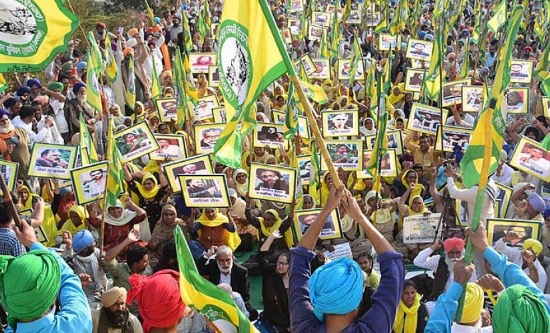
On 26 January 2021, Republic Day in India, tens of thousands of farmers rallied in the capital New Delhi, with some storming the Red Fort complex which was once the seat of the Mughal Dynasty. This was the latest display of the power of the new milestone movement against Narendra Modi’s government and the fascist ascendency that seemed irreversible in the 2019 election period. The 2019-20 nationwide movement against the racist Citizenship Amendment Act (see FRFI 274) was suppressed through exploiting the coronavirus emergency and the use of anti-terror laws against the protesters. But the sheer scale of the farmers’ protests has forced the Modi government to the negotiation table. ABDUL VAJID reports.
The protests were triggered in August 2020, when the government revealed plans to introduce three laws collectively known as the Farm Bills in Parliament: the Farmers’ Produce Trade and Commerce Act; the Farmers Agreement on Price Assurance and Farm Service Act; and the Essential Commodities Act. These Bills were presented to the public as a way of making sales of agricultural produce easier and more direct by taking away intermediaries and regulations, with Modi promising ‘transformation of the agricultural sector to empower tens of millions of farmers’.
But behind the rhetoric, the Bills are an attempt by the government to take away regulations and institutions like the Agricultural Produce Market Committee and Minimum Support Price on goods that have prevented a naked dominance of large private agribusiness and the global market.
These locally based institutions, mostly consisting of people who are accessible to farmers, are subsidised by the government and have special provisions, like prepayment on agreed produce, which help farmers to invest in crops and machinery without interruption. The Bills essentially weaken the power of local regulatory institutions and thus usher in the power of retail and agricultural corporations in determining prices and contracts. Both rich farmers with large landholdings and middle and marginal farmers immediately understood this as a threat to their livelihoods and have addressed the laws as naked ploys to empower agribusiness over traditional stakeholders in the sector.
Starting regionally in states like Punjab and Haryana, which disproportionately represent India’s agricultural output, the protests quickly grew. Farmers’ organisations and unions came together and created coalitions such as the All India Kisan Sangharsh Coordination Committee, an umbrella organisation of 250 organisations. After the bill was signed into law by President Ram Nath Kovind, on 25 September opposition parties and unions called for a Bharat Bandh (national general strike), and in Punjab the farmers’ unions blocked railways at six different locations for three days. The Rail Roko (‘stop the trains’) campaign continued into October and November. On 25 November, with their state governments refusing to back them, farmers marched on New Delhi and occupied the borders, blocking the city’s logistical network. According to media estimates, 200-300,000 farmers were occupying various border points of Delhi. On 26 November, a 250-million strong general strike across India took place.
From the beginning, protests were met with aggressive martial treatment by the state: protesters were attacked with tear gas, water cannon, lathi (baton) charges, and live fire by the police and paramilitaries. Around 120 people have been killed so far by police violence, starvation, cold and protest suicides. But the militancy and spirit of the protest were such that the protesters not only never retreated, but strategically converged and organised on such a scale that police and paramilitaries were severely outnumbered. Despite the government and mainstream media’s attempts to demonise the protesters as being funded by Pakistan or influenced by ‘Sikh separatism’/Naxalism/Islamist terrorists among other things, the combativeness of the farmers and the support they have received domestically and internationally have forced the government to the negotiating table. By 30 December the government had conceded on two of the movement’s demands, scrapping a rise in electricity tariffs and penalties for stubble burning.
The protests are the culmination of a crisis the Indian agricultural sector has been facing for half a century. After the so-called Green Revolution of the 1960s, the push to Genetically Modified Organisms and limited crop models for the sake of global markets have meant the slow depletion of soil, ever-increasing dependence on expensive chemicals and fertilisers and an undiversified crop economy. These have caused a considerable fall in profits in agriculture especially for small farmers. This led to high dependence on predatory loans by private and government agencies, with many farmers accruing unpayable debts. Since 1995, officially about 300,000 farmers have committed suicide to escape these crushing debts. According to the ruling Bhartiya Janatha Party (BJP), which has been pushing neoliberal restructuring of Indian economy, the further empowerment of agribusiness is supposed to solve the agrarian distress. But farmers themselves have a different view.
The farmers’ organisations do not represent the whole of the peasant society, which also consists of the masses of marginal farmers, landless farmers, tribal farmers, and agrarian labourers who depend for their own livelihood on exploitative relationships with the middle and large farmers that lead the movement. The unorganised sectors make up the majority of Indian peasantry, most living in destitution. Though they are participating in the movement, no organisations represent their independent interests, such as land redistribution and agricultural communes, which have been off the table since the 1970s. The coming dominance of the market economy will only further disempower these sections.
Despite these limits, the protests do represent a much-needed rift in the ascendant movement of Hindutva fascism and BJP neoliberalism. They have managed to coalesce around an anti-BJP movement rather than being a single-issue campaign. The radical sections of the farmer’s movement have been expressing solidarity with other victims of the government and fascist forces. Facing a movement led and nurtured by ordinary farmers who are unwilling to give up and prepared to stay in Delhi for months to come, the government is not able to get out of this easily.
Fight Racism! Fight Imperialism! 280 February/March 2021




